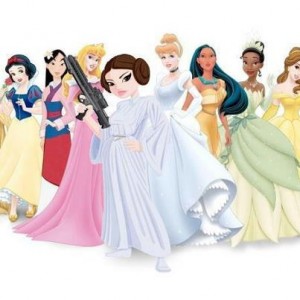We couldn’t have planned a more timely reading of Jenkins’s article on grassroots versus Lucasfilm. Now that Princess Leia is the newest Disney Princess, I can now buy my bun earmuffs and my Tinkerbell wings together at the Disney store. What makes the Star Wars franchise so successful, other than its complete understanding and implementation of merchandising (see attached clip from Mel Brooks’s Spaceballs), is its ability to inspire fans. This inspiration has spurred fans to create extensions of Lucas’s world, and not always to Lucas’s liking. The internet, for its part, has brought forth these creations into the light. What once existed under the radar for only a few friends and family members can now be distributed to a mass audience by uploading your creation. As Jenkins points out, our modern system of industrial arts requires the financial support of a wider audience, but from my view, we must learn to balance this with the large number of artists and creators that exist outside of those being bankrolled by the industry (Jenkins, 2012). It is those artists that aren’t being bankrolled that are bringing this full circle. From their Star Wars inspired works, they are the folk culture re-emerging.
Then comes the inevitable discussion of labor and economics. Oh why couldn’t we just continue reading about culture? Because someone has to pay the bills. So the internet has changed labor and production. Shock! I’m glad that Banks and Humphreys are not going overboard in the way that Marxists look at voluntarily produced work as exploitive. I appreciate that they are attempting to look at this type of user production in economic terms. While encouraging us to think of user feedback and production as more than “a refined form of focus-group testing”, the authors give us the applicable example of a group of users currently providing constructive criticism and content to the market, gamers (Banks and Humphreys, 2008). Since the advent of the Atari brought gaming into the homes of middle class families, gaming has become a staple of home entertainment for many. By providing constructive feedback to game companies and engaging in content creation, the gamer is also getting something for their labor, a better gaming experience. This is not to say that those contributions are not worthy of monetary reward, but it does merit pointing out that there is already value returned to the consumer. Even the authors point out that gamers are aware that their contributions have value, and that perhaps they are willing participants in their unpaid contributions. I also appreciate that the authors recognize that companies must find a balance is their use of paid versus unpaid labor, quoting from Fox, “without making non-money feel like a sucker” (Fox, 2007:33).

I want Leia bun earmuffs!
In honor of these achievements and recognitions, we in Government Publications wanted to point out some aspects of NASA’s history of space exploration and share some resources that may serve as a jumping off point to any studies in these topics.推特账号购买
우리의 덤프는 기존의 시험문제와 답과 시험문제분석 등입니다. DumpTOP에서 제공하는EMC D-PST-DY-23시험자료의 문제와 답은 실제시험의 문제와 답과 아주 비슷합니다. DumpTOP는 여러분이 한번에EMC D-PST-DY-23인증시험을 패스함을 보장 드립니다.
This article is truly excellent, and I’ve gained a lot of useful knowledge from it. The Reliable C_THR84_2405 test voucher exam is coming soon. Fingers crossed for success!
Absolutely brilliant content, no hesitation to like it. The Reliable NSE7_EFW-7.2 exam answers resources are top-notch and free to everyone.
This article gave me new perspectives, thank you for sharing! I achieved my promotion and salary raise using this D-PDD-OE-23 dumps questions. Now it’s free to everyone. Best of luck with your own career advancements!
GoShikenは、試験に最適な試験AZ-500試験ガイドを提供します。 AZ-500練習トレントの有効性と信頼性は、専門家によって確認されています。多くのお客様が当社のヘルプでAZ-500試験に合格しています。 AZ-500テスト資料はホームページで更新され、AZ-500認定試験に関連する情報をタイムリーに更新します。最も有効で費用対効果の高いAZ-500準備資料を入手できるように、pdf塾でプロモーションを行います。そのため、AZ-500トレーニングガイドを安心してお選びいただけます。
Thank you for the article; it was incredibly impressive and thought-provoking. Thanks to the Reliable ADM-261 exam camp sheet, I got promoted and received a salary raise. Now, I’m offering it for free. Wishing you all success in your careers!
This article is truly worth reading, and I have learned a lot. The Questions and answers D-ISM-FN-23 free questions are free—use them to elevate your career and salary!
This article is absolutely stunning, I appreciate you sharing it. Upgrade your IT skills with free Test C_P2W_ABN prep. Wishing you all the best!
クライアントがNSE7_SDW-7.2-JPNガイドトレントの支払いに成功すると、5〜10分でシステムから送信されたメールを受信します。その後、彼らはメールを流してログインし、ソフトウェアを使用してすぐに学習することができます。その時間は学習者にとって非常に重要であり、誰もが効率的な学習ができることを望んでいます。クライアントがすぐにNSE7_SDW-7.2-JPNテストトレントを使用できるのは、NSE7_SDW-7.2-JPN試験問題の大きなメリットです。使用を開始すると、試験のシミュレーションやタイミング機能の向上など、NSE7_SDW-7.2-JPN実践ガイドのさまざまな機能と利点をお楽しみいただけます。
Your article was so inspiring, thank you for sharing it with me. Sharpen your IT knowledge with free CISM new dumps ebook. Wishing you success!
It’s truly astonishing, thank you for the share! The HQT-4420 latest test simulator online exam questions are free for everyone—unlock career growth and salary increases!
This article is incredible, thank you for sharing it! Improve your IT skills—free C-C4H41-2405 reliable exam camp free is shared! Best of luck with everything!
CPHQ認定試験と言ったら、信頼できるのを無視することは難しい。GoShiken のCPHQ試験トレーニング資料は特別にデザインしてできるだけあなたの仕事の効率を改善するのソフトです。GoShikenは世界的にこの試験の合格率を最大限に高めることに力を尽くしています。
This content is incredible, liking it without delay. Free Test UiPath-ADPv1 pdf exam resources—your gateway to promotions and higher pay!
Your article took my breath away, thank you for sharing! The C_ARSCC_2404 Popular Exams exam questions are available for free—your ticket to a promotion and salary increase!
你已經報名參加Salesforce的PDI認證考試了嗎?“馬上就要到考試的時間了,但是我還是沒有信心通過考試,應該怎麼辦呢?有捷徑可以讓我順利通過考試嗎?看參考書的時間也不夠了。”你現在有這樣的心情嗎?不用著急,即使考試時間快到了,也還是有機會可以好好準備考試的。你肯定想問是什麼機會了吧。它就是KaoGuTi的PDI考古題。這是一個高效率的資料,它可以在短時間內為考試做好準備。因為這個考古題的命中率非常高,只要你認真記住考古題裏面出現的問題和答案,那麼你就可以通過PDI考試。
SAPのC_TS4FI_2023-JPN試験に趣味があると、躊躇わなく、我々GoShikenで問題集のデーモをダウンロードして試すことができます。デーモ版によって、このC_TS4FI_2023-JPN問題集はあなたに適合するかと判断します。適合すると、あなたは安心で購買できます。弊社GoShikenのC_TS4FI_2023-JPN問題集は必ずあなたの成功へ道の秘訣です。
Your article is breathtaking, thank you for sharing! Grab your free PAL-I review guide test questions—promotion and salary increases await!
I feel so much more enlightened after reading it. This Exam A00-415 Bootcamp helped me get a promotion and salary hike. I’m now making it available for free. Wishing you all career success!